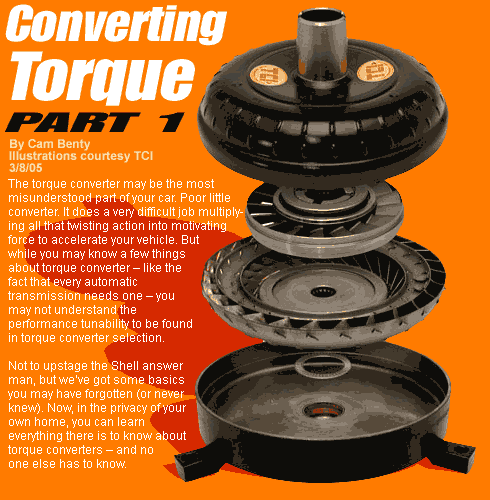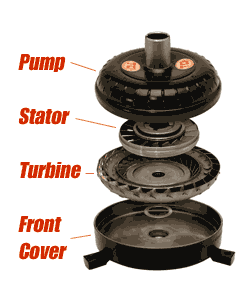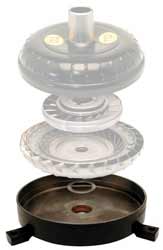| 
(click here to read
PART 2)
WHAT IS A “TORQUE CONVERTER?”
A torque converter is a type of fluid coupling, which allows
the engine to spin somewhat independently of the transmission.
If the engine is turning slowly, such as when the car is
idling at a stoplight, the amount of torque passed through
the torque converter is very small, so keeping the car still
requires only a light pressure on the brake pedal.
If you were to step on the gas pedal while the car is stopped,
you would have to press harder on the brake to keep the car
from moving. This is because when you step on the gas, the
engine speeds up and the transmission pumps more fluid into
the torque converter, causing more torque to be transmitted
to the wheels.
INSIDE A TORQUE CONVERTER
 As shown in the picture below, there are four major components
to a conventional non-lockup torque converter: Front Cover,
Turbine, Stator and Pump. Aftermarket bearings in multiple
sets, hi-performance sprag assemblies, billet mounting fronts,
special steel flame-hardened hubs, component furnace brazing & special
surface coatings are some of the steps taken to enhance strength,
performance and longevity. As shown in the picture below, there are four major components
to a conventional non-lockup torque converter: Front Cover,
Turbine, Stator and Pump. Aftermarket bearings in multiple
sets, hi-performance sprag assemblies, billet mounting fronts,
special steel flame-hardened hubs, component furnace brazing & special
surface coatings are some of the steps taken to enhance strength,
performance and longevity.
The “Front Cover” of the torque converter is
bolted to the flywheel of the engine, so it turns at whatever
speed the engine is running at. The fins that make up the “Pump” of
the torque converter are attached to the housing, so they
also turn at the same speed as the engine. The cutaway above
shows how everything is connected inside the torque converter.

The “Pump” of the torque converter is welded
to the housing. The pump of a torque converter is a type
of centrifugal pump. As it spins, fluid is flung through
the fins to the outside, much as the spin cycle of a washing
machine flings water and clothes to the outside of the wash
tub. As fluid is flung to the outside, a vacuum is created
that draws more fluid in at the center.
|

